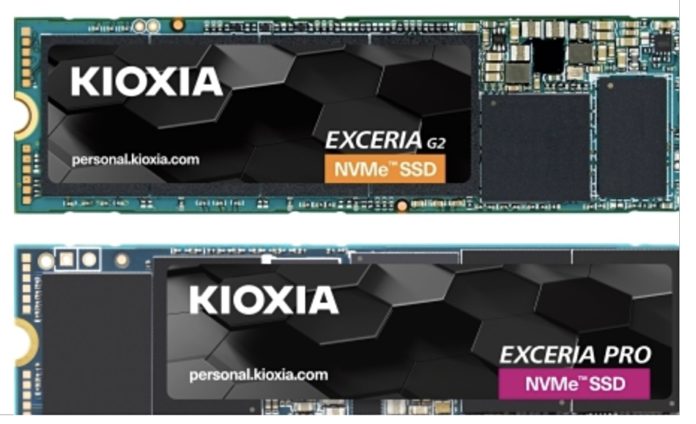Kioxia has pre-announced another PCIe Gen-4 SSD, promising around 7GB/sec of sequential read performance, while Samsung has revealed 200-layer NAND technology.
The EXCERIA PRO — YES, IT IS ALL-CAPS — is in development and will use a PCIe Gen-4 x 4 interface, delivering more than twice the read bandwidth of the existing EXCERIA PLUS which uses the PCIe Gen-3 interface — half the speed of PCIe 4.
It is an M.2 2280 gumstick card format drive and we have a picture of it:

As you can see, it is accompanied by a second-generation Exceria NVMe drive, using the same M.2 format, and we understand this sticks with the Gen-3 PCIe interface. It is much, much slower than the PRO model, and only pumps out something over 2GB/sec sequential read performance. The maximum capacity will be 2TB.
Kioxia doesn’t provide any NAND details beyond saying the two drives use its BiCS 3D NAND. The existing PLUS and Gen-1 NVMe EXCERIA drive use BiCS 4 96-layer TLC NAND. Kioxia introduced BiCS 5 112-layer NAND in the first 2020 quarter and then BiCS 6 162-layer NAND in 2021’s first quarter.
We expect the two new Exceria drives (sorry, all-caps is exhausting) will upgrade to BiCS 5, but they might go straight to BiCS 6.
As a background point, the Exceria brand came into being when Kioxia was created from Toshiba Memory Corporation in October 2019, with the RC500 SSD being rebranded the Exceria Plus.
Both are workstation and gamer PC drives, and the Pro model indicates what we can look forward to in terms of server PCIe 4 M.2 SSD performance.
Samsung 3D NAND
Samsung reported its quarterly earnings and revealed it had a working 200-layer 3D NAND device. We have updated our table of suppliers’ 3D NAND offerings to reflect this:

We expect this table to change substantially by the end of the year as SK hynix is acquiring Intel’s NAND business. It’s apparent that Intel’s 3D NAND technology will somehow be blended with that of its acquirer, SK hynix, but we don’t know how yet. A mooted fifth generation of Intel NAND may be cancelled.
The YMTC NAND roadmap is temporarily stalled, we think, because of the owning Tsinghua Unigroup’s bankruptcy problems. This could leave YMTC at a layer count disadvantage if the owning group’s money problems prevent it from developing its Xtacking technology beyond a second generation.








